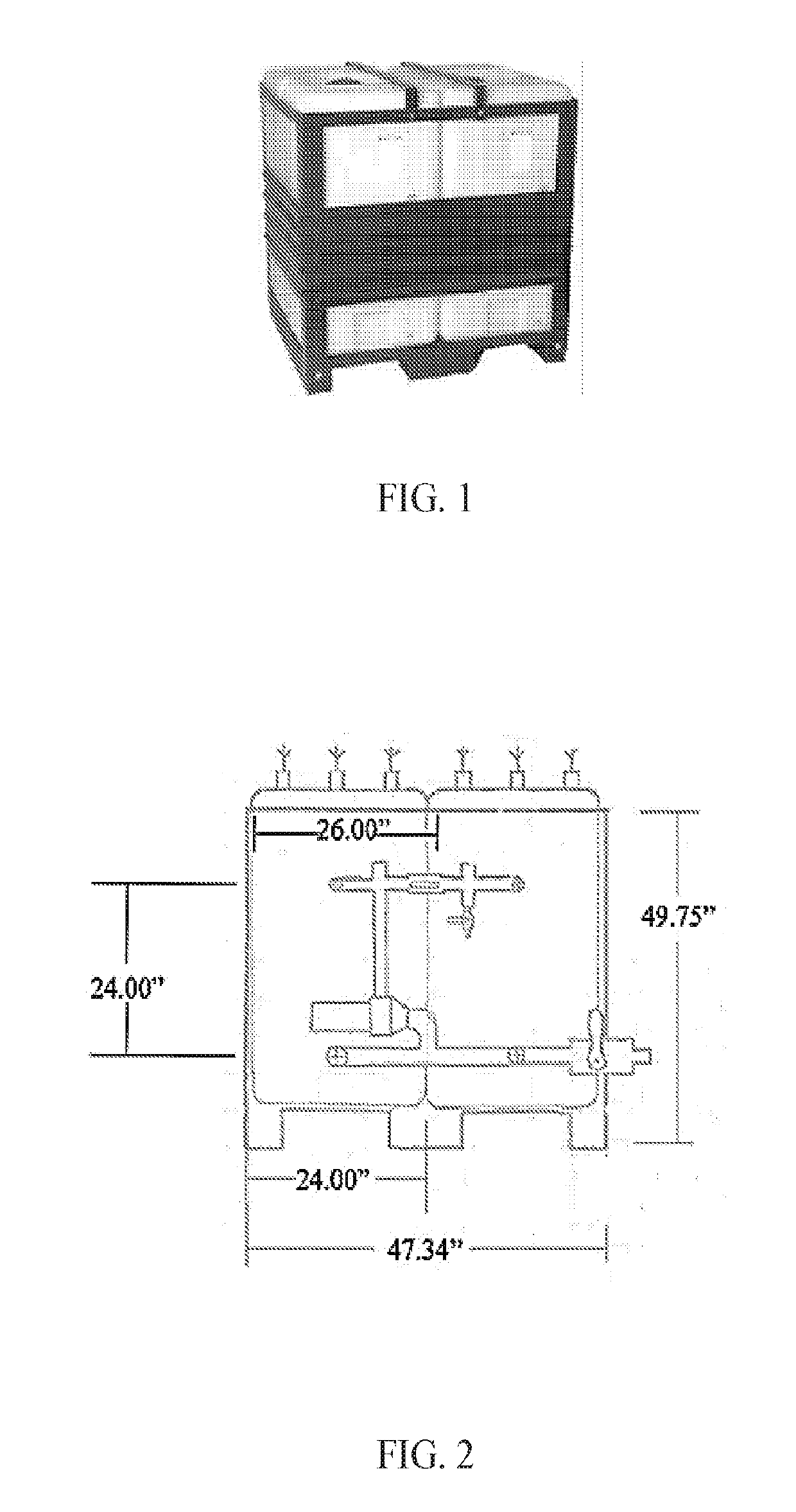Novel Fermentation Systems and Methods
a technology of fermentation system and composition, applied in the direction of fungi, non-ionic surface active compounds, water/sewage treatment by irradiation, etc., can solve the problems of reduced flow, high cost per propagule density, and inability to apply microbial products to large-scale operations, so as to improve the flow of oil, enhance the recovery of crude oil, and enhance the effect of oil recovery
- Summary
- Abstract
- Description
- Claims
- Application Information
AI Technical Summary
Benefits of technology
Problems solved by technology
Method used
Image
Examples
example 1
Multi-Tank Fermentation System
[0147]A portable and distributable plastic reactor was constructed as shown in FIGS. 1 and 2. The reactor has two plastic square tanks with two loops for mass exchange between the two tanks.
[0148]The top of the system was equipped with a pumping mechanism to pull from a first tank and deposit in a second tank, which accounts for one of the loops. The other loop was at the bottom of the tank and relied on hydrostatic pressure to equalize the volumes in the tanks.
[0149]The addition of filtered air into the tanks was controlled by a sparging mechanism that ran through a bubbler. The filtered air for sparging was generated via a high volume aquatic pumping system. There were two 72 inch bubblers per tank, resulting in a total of four per system. An air compressor was also used to add filtered air into the top and bottom loops for extra aeration.
[0150]The top loop was equipped with a sight glass to allow for viewing the culture's turbidity, color, thickness ...
example 3
of the Multi-Tank Reactor Using a Culture Medium Comprising Antibiotics
Culture Media
[0168]
ReagentWeight (g / L)Urea1Yeast Extract5Glucose60Canola Oil70 ml / LStreptomycin (Antibiotic)0.1Oxytetracycline (Antibiotic)0.01
Prepping the Multi-Tank Reactor
[0169]The total volume of the two-tank reactor was 750 L, so the appropriate amount of the reagents above were determined and weighed out. Dry ingredients were dissolved in a barrel using filtered water. Canola oil was not added during the dissolving step. Antibiotics were kept separate, and dissolved in DI water in a large beaker.
[0170]Next the dissolved media were added to the reactor. The reactor was filled up to ˜185 gallons total with filtered water, followed by the canola oil. The final volume was 100 gallons in each tank, thus equaling 200 gallons total.
[0171]The starting temperature was at least 23° C. but no higher than 30° C. Once temperature was established in the range of 23 to 30° C., inoculum was added from the mixer, followed b...
example 4
[0179]An experiment was conducted to show the efficacy of a Starmerella culture on paraffin liquefaction. The results of the experiment can be seen in FIG. 2, and the results of a culture are marked as “Star3.”
[0180]Twenty-one (21) microbial and chemical emulsification products (including commercial) were investigated for paraffin degradation efficacy. Fifty (50) mL Falcon tubes with a working volume of 25 mL were used in the experiment. Solid paraffin was obtained from an oilfield. Four (4.0) grams of solid paraffin was weighed and then added into each Falcon tube and 20 mL of each liquid from Table 1 was added to the Falcon tubes. All the Falcon tubes were then horizontally placed in an ENVIRO GENE incubator at 30° C. to 40° C. and gently mixed. After different incubation times (1, 2, or 4 days), the tubes were collected and analyzed.
[0181]Three (3) sets of experiments were carried out at different incubation times and different temperatures. The first set of experimen...
PUM
| Property | Measurement | Unit |
|---|---|---|
| volume | aaaaa | aaaaa |
| temperature | aaaaa | aaaaa |
| diameter | aaaaa | aaaaa |
Abstract
Description
Claims
Application Information
 Login to View More
Login to View More - R&D
- Intellectual Property
- Life Sciences
- Materials
- Tech Scout
- Unparalleled Data Quality
- Higher Quality Content
- 60% Fewer Hallucinations
Browse by: Latest US Patents, China's latest patents, Technical Efficacy Thesaurus, Application Domain, Technology Topic, Popular Technical Reports.
© 2025 PatSnap. All rights reserved.Legal|Privacy policy|Modern Slavery Act Transparency Statement|Sitemap|About US| Contact US: help@patsnap.com

